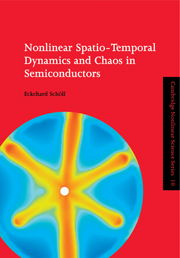Book contents
- Frontmatter
- Contents
- Preface
- Chapter 1 Semiconductors as continuous nonlinear dynamic systems
- Chapter 2 Concepts of nonlinear charge transport in semiconductors
- Chapter 3 Pattern formation and oscillatory instabilities in semiconductors
- Chapter 4 Impact-ionization-induced impurity breakdown
- Chapter 5 Nonlinear carrier dynamics in crossed electric and magnetic fields
- Chapter 6 Stationary and oscillating domains in superlattices
- Chapter 7 Spatio-temporal chaos
- References
- Index
Chapter 7 - Spatio-temporal chaos
Published online by Cambridge University Press: 17 September 2009
- Frontmatter
- Contents
- Preface
- Chapter 1 Semiconductors as continuous nonlinear dynamic systems
- Chapter 2 Concepts of nonlinear charge transport in semiconductors
- Chapter 3 Pattern formation and oscillatory instabilities in semiconductors
- Chapter 4 Impact-ionization-induced impurity breakdown
- Chapter 5 Nonlinear carrier dynamics in crossed electric and magnetic fields
- Chapter 6 Stationary and oscillating domains in superlattices
- Chapter 7 Spatio-temporal chaos
- References
- Index
Summary
Introduction
Spatio-temporal chaos is a feature of nonlinear spatially extended systems with large numbers of degrees of freedom, as described for instance by reaction–diffusion models of activator–inhibitor type. In this chapter we shall study a model system of this type that was introduced in Chapter 2 for layered semiconductor heterostructures, and used for a general analysis of pattern formation in Chapter 3. Here we shall investigate in detail the complex spatio-temporal dynamics including a codimension-two Turing–Hopf bifurcation, and asymptotic and transient spatio-temporal chaos. Chaos control of spatio-temporal spiking by time-delay autosynchronization is applied. The extensive chaotic state is characterized using Lyapounov exponents and a Karhunen–Loève eigenmode analysis.
Spatio-temporal spiking in layered structures
For understanding spatio-temporal chaos it is important to study first the elementary spatio-temporal patterns, which may eventually – in the course of secondary bifurcations – evolve into chaotic scenarios. One such elementary pattern, which has been observed experimentally in various different semiconductor devices exhibiting SNDC, e.g. layered structures such as p–n–p–i–n diodes (Niedernostheide et al. 1992a) and p–i–n diodes (Symanczyk et al. 1991a), or in impurity-impact-ionization breakdown (Rau et al. 1991, Spangler et al. 1992), and in electron–hole plasmas (Aliev et al. 1994), is the spiking mode of current filaments. The properties of localized spiking structures have been studied theoretically in detail by Kerner and Osipov (1982, 1989) in general reaction–diffusion systems. Spiking in a simple chemical reaction–diffusion model – the Brusselator – has been reported by De Wit et al. (1996).
- Type
- Chapter
- Information
- Nonlinear Spatio-Temporal Dynamics and Chaos in Semiconductors , pp. 290 - 370Publisher: Cambridge University PressPrint publication year: 2001



